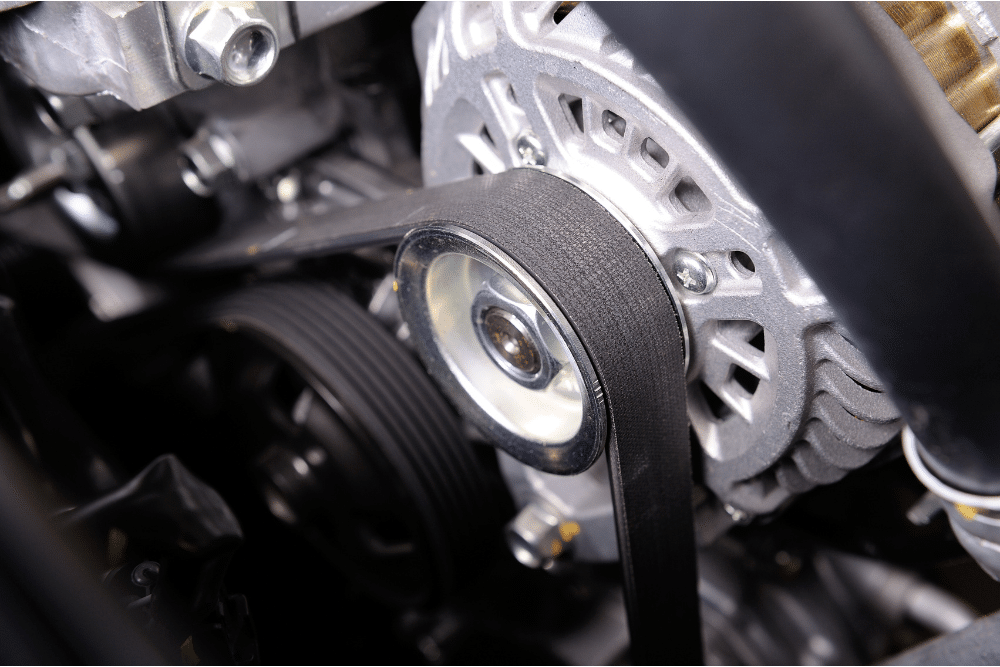TL;DR: A failing timing belt shows up as ticking noises, misfires, or oil leaks. Ignoring the signs risks engine failure and costly repairs. Regular inspections and timely replacement at Springboro Automotive can save you thousands and keep you road-ready.
How do you know if your timing belt is going bad? Early signs include ticking noises, engine misfires, hard starts, oil leaks, or visible wear on the belt itself. Ignoring these symptoms could lead to serious internal engine damage that’s far more costly to repair than a simple timing belt replacement.
Your timing belt keeps your engine running in perfect rhythm, and when it starts to fail, things go downhill fast. That’s why it’s critical to recognize the warning signs early.
In this guide, we’ll break down:
- Why the timing belt is so important
- The most common symptoms of a failing belt
- What happens if it breaks
- When and how often to replace it
- Why choosing the right shop matters
- What other parts should be inspected at the same time?
Whether you’re commuting to Dayton, taking a weekend trip to Miamisburg, or visiting family in Lebanon, spotting issues early can prevent unexpected breakdowns and save you thousands in repairs.
Why the Timing Belt Is So Important
The timing belt is essential for keeping your engine’s camshaft and crankshaft moving in precise timing. This synchronization ensures the valves open and close at exactly the right time, letting fuel and air in while pushing exhaust gases out. Even the slightest slip, stretch, or missing tooth can throw off this balance, leading to poor performance, misfires, or, in severe cases, catastrophic engine damage.
At Springboro Automotive, our ASE-certified technicians have seen everything from mild wear that was caught just in time to complete engine failure caused by a neglected belt. In many cases, drivers didn’t realize they were on borrowed time until it was too late. The good news is that most timing belt issues are entirely preventable with regular inspections, timely replacements, and attention to early warning signs.
Common Timing Belt Warning Signs
1. Ticking or Clicking Noise from the Engine
A rhythmic ticking or clicking sound coming from under the hood, especially when your vehicle is idling, can be one of the earliest signs that your timing belt is starting to wear out. This noise often happens when the belt’s teeth are slipping or the belt has become loose, causing the valves to open and close slightly off-schedule. Left unchecked, this can lead to poor engine performance or even severe damage. If you notice this sound while driving through Centerville or Franklin, it’s smart to get a professional timing belt inspection before the issue escalates.
2. Trouble Starting or Misfiring
A slipping or damaged timing belt can throw off the exact coordination between the engine’s valves and pistons, leading to hard starts, rough idling, or engine misfires. In some cases, your vehicle might crank for longer than usual before firing up, or it could stall unexpectedly while driving. These issues may seem minor at first, but they can quickly turn into a no-start situation. If you experience this, especially before a planned trip to Miamisburg or Waynesville, it’s best to have a trusted shop perform a timing belt inspection right away.
3. Visible Belt Wear or Cracks
If you’ve recently had other engine work done and the timing belt is visible, take a close look for any physical damage. Warning signs include:
- Cracks that indicate the rubber is drying out or becoming brittle.
- Fraying edges that can suggest misalignment or contact with another component.
- Missing teeth can cause the belt to slip and throw off engine timing.
- Glazing (shiny, smooth spots) from excessive friction or slipping.
Even if the belt looks intact, don’t assume it’s in perfect condition. Rubber and composite materials naturally degrade over time, and Ohio’s hot summers followed by freezing winters can speed up this process. That’s why it’s critical to follow your vehicle’s recommended replacement schedule, regardless of how the belt appears to the naked eye.
4. Engine Oil Leaks Near the Front of the Motor
The timing belt sits behind a protective cover, but it isn’t immune to damage from nearby oil leaks. Seals or gaskets, such as the camshaft or crankshaft seal, can allow oil to seep out over time. When oil reaches the belt, it soaks into the material, causing it to soften, weaken, and wear out faster than normal. If you notice dark spots or puddles in your driveway, especially near the front of the engine bay, have it checked promptly. Addressing a small leak now can save you from a failed belt and a costly repair later, whether you’re heading to Waynesville, Lebanon, or just running errands around Springboro.
5. Rough Idling or Unusual Vibrations
A worn or damaged timing belt can disrupt the precise coordination of your engine’s moving parts, creating an uneven running condition. This can lead to rough idling where the engine feels jumpy or unstable, and in some cases, you may feel unusual vibrations through the steering wheel, seat, or even the floorboard when stopped. These symptoms may also be accompanied by reduced fuel efficiency or decreased power. Don’t overlook them what starts as a small vibration could be a sign that your timing belt is slipping and your engine is out of sync.
If you’re noticing any of these timing belt warning signs, like ticking noises, engine misfires, or oil leaks, don’t wait until it’s too late.
Call Springboro Automotive at 937-746-7999 or stop by 216 Hiawatha Trail, Springboro, OH 45066 to schedule your timing belt inspection today and avoid costly repairs or roadside breakdowns.
How Often Should You Replace Your Timing Belt?
Most vehicle manufacturers recommend replacing the timing belt every 60,000 to 100,000 miles, but this is only a general guideline. Your driving habits and environment play a big role in how long the belt lasts. Frequent short trips around Springboro, repeated stop-and-go driving in Centerville, or towing heavier loads can put extra strain on the belt and its components.
If you’ve recently purchased a used vehicle and there’s no documented service record for the timing belt, it’s best to schedule a replacement right away. This small investment acts as cheap insurance, protecting your engine from the severe and costly damage that can occur if the belt fails unexpectedly.
The Risk of Ignoring Timing Belt Problems
When a timing belt fails, it often happens without warning, and the damage can be devastating. If the belt breaks while you’re on the highway heading to Miamisburg for a weekend getaway, you could instantly face:
- Bent valves that no longer seal properly
- Damaged pistons from valve-to-piston contact
- A broken camshaft that requires extensive engine teardown
- A complete engine replacement in the worst cases
The cost of these repairs can easily be three to five times higher than simply replacing the belt on schedule. That’s why preventative maintenance isn’t just a recommendation, it’s the smartest and most cost-effective choice for keeping your vehicle safe and reliable.
Why Choose Springboro Automotive for Timing Belt Service
When it comes to timing belt replacement, precision isn’t optional; it’s essential. At Springboro Automotive, we ensure your vehicle gets the most accurate, reliable service possible:
- Snap-on and Autel diagnostic tools – Used to confirm engine timing is perfectly set before, during, and after replacement.
- BG Products – Applied to clean and protect critical engine components, extending the life of your new belt and related parts.
- Hofmann alignment equipment – Ensures steering and suspension are properly aligned if any adjustments are needed after engine work.
- ASE-certified technicians – Experienced professionals who understand the importance of accuracy and attention to detail.
- NAPA 36-month/36,000-mile nationwide warranty – Peace of mind whether you’re commuting to Centerville, visiting Waynesville, or taking a long trip across Ohio.
With our combination of advanced tools, expert knowledge, and commitment to doing the job right the first time, your timing belt replacement is in the best hands possible.
Getting Ready for a Trip? Schedule a Belt Inspection First
Before you hit the road for:
- Back-to-school season
- Fall weekend drives
- Holiday trips to see family
…make sure your vehicle is road-ready. A quick timing belt inspection can spot early wear and prevent roadside breakdowns.
Other Parts to Inspect Alongside the Timing Belt
When replacing your timing belt, it’s smart to inspect or replace:
- Water pump
- Tensioners
- Idler pulleys
- Drive belts
Replacing these components at the same time saves labor costs and reduces the chance of future breakdowns.
Frequently Asked Questions About Timing Belts
How can I tell if my timing belt needs replacing?
You can tell if your timing belt needs replacing by looking for warning signs like ticking noises, engine misfires, oil leaks near the belt cover, or visible cracks and fraying. A professional timing belt inspection can confirm its condition and prevent unexpected breakdowns.
What happens if my timing belt breaks while driving?
If your timing belt breaks while driving, it can cause severe engine damage, including bent valves, broken pistons, or a destroyed camshaft. In many cases, this leads to costly repairs or a full engine replacement, so timely replacement is critical.
Can I drive with a bad timing belt?
Driving with a bad timing belt is risky and can result in sudden engine failure. Even if the belt hasn’t broken yet, wear and damage can cause it to slip, leading to dangerous driving situations and expensive repairs.
Does my car have a timing belt or a timing chain?
Whether your car has a timing belt or a timing chain depends on the make, model, and year. Timing chains generally last longer but can still wear out, while belts require replacement at specific mileage intervals to keep the engine running smoothly.
Protect Your Engine in Springboro – Schedule a Timing Belt Inspection Today!
Your timing belt may be out of sight, but it should never be out of mind. Spotting issues early, before a long trip or even your daily commute, can help you avoid unexpected breakdowns and expensive engine repairs.
At Springboro Automotive, located at 216 Hiawatha Trail, Springboro, OH 45066, we use industry-leading diagnostic tools, ASE-certified technicians, and a commitment to quality workmanship to get the job done right the first time. Whether you’re driving around town or heading out of Springboro for a weekend away, we’ll make sure your vehicle is road-ready and reliable.
Schedule your timing belt inspection online or call 937-746-7999 to speak with our team.

